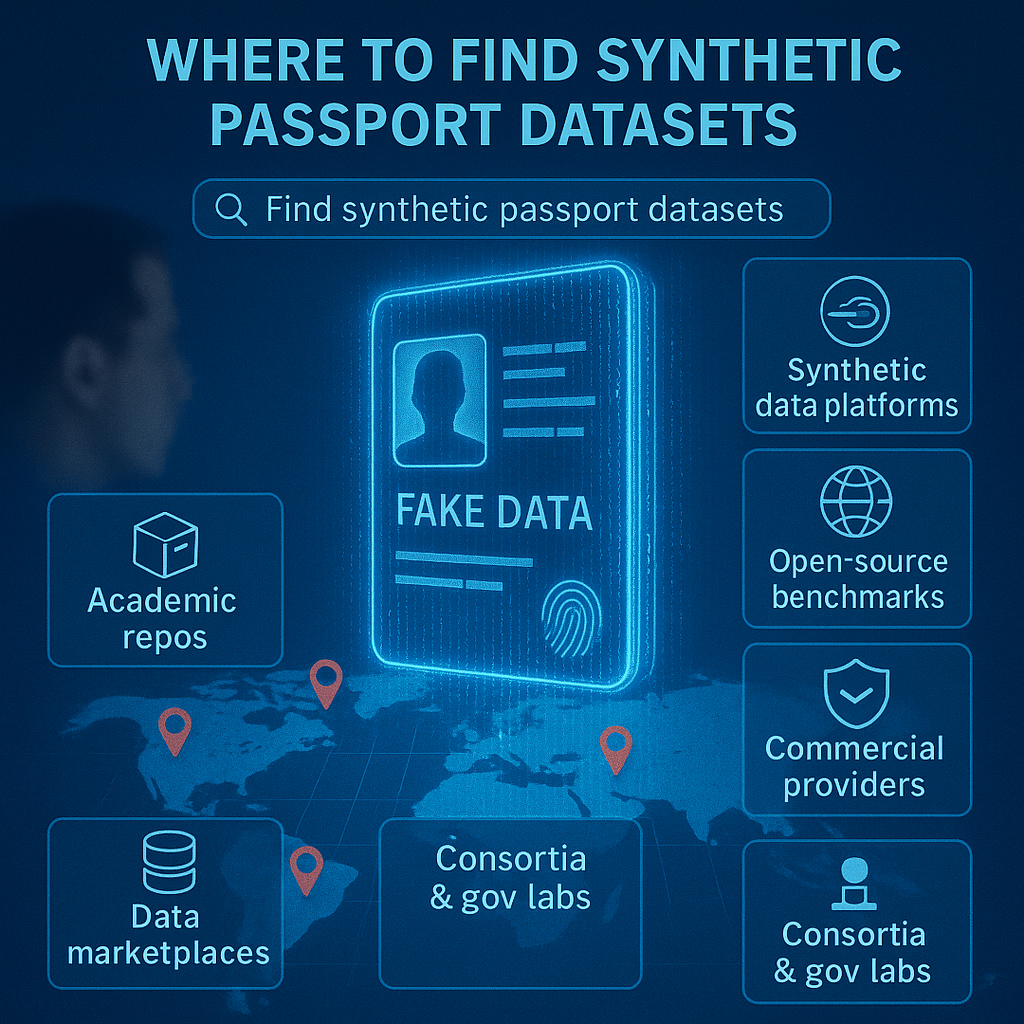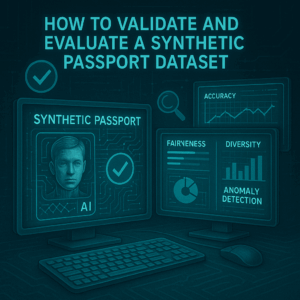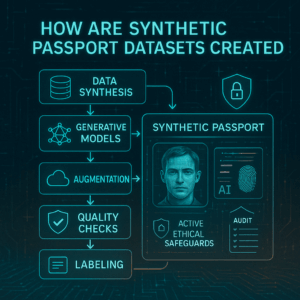The field of artificial intelligence (AI), particularly in computer vision and identity verification, is a data-driven discipline. To build powerful and accurate AI models, developers and researchers need massive, high-quality datasets. However, when it comes to sensitive information like passports and other government-issued IDs, collecting real-world data is fraught with legal, ethical, and logistical challenges. This is where the quest for synthetic data begins.
A synthetic passport dataset is a collection of artificially generated, yet highly realistic, passport images and associated data. These datasets are a cornerstone of modern AI development, allowing organizations to train and test their models without risking privacy violations. But where can one actually find these specialized datasets? The answer is a blend of publicly available resources, commercial providers, and do-it-yourself generation tools.

1. Open-Source and Public Platforms
For researchers, students, and independent developers, the most accessible entry point is through open-source platforms and academic repositories. These sources often provide datasets for free or at a low cost, promoting research and innovation in the AI community.
- Kaggle: This is a top-tier platform for finding a wide variety of datasets, including those for computer vision tasks. A simple search on Kaggle for “synthetic passport dataset” or “ID document dataset” can yield several options. These datasets are often created by researchers or hobbyists and may vary in quality, but they provide an excellent starting point for experimentation and learning.
- Example: Datasets on Kaggle may contain thousands of synthetically generated passport images, often with annotations for facial landmarks, text fields, and Machine Readable Zones (MRZs), which are crucial for optical character recognition (OCR) tasks.
- GitHub and Academic Repositories: Many research papers and academic projects release their synthetic datasets on GitHub or other public repositories to ensure their work is reproducible. These datasets are often highly specific, designed to address a particular challenge like presentation attack detection (PAD) or forgery detection.
- How to find them: Searching for academic papers on platforms like arXiv, ResearchGate, or Google Scholar using keywords such as “synthetic passport dataset,” “hybrid data generation,” and “biometric authentication” can lead you to these valuable resources. The papers often include links to the datasets in their appendices or on the authors’ project pages.
- Hugging Face: While primarily known for its natural language processing (NLP) models and datasets, Hugging Face is also expanding to include computer vision datasets. Developers may upload synthetic datasets here for public use, often with detailed documentation on how the data was generated and its intended use.
Advantages of Open-Source Datasets:
- Cost-Effective: Often free to download and use.
- Community-Driven: Supported by a community of developers and researchers.
- Reproducibility: Facilitates scientific research by providing a common dataset for comparing model performance.
Disadvantages of Open-Source Datasets:
- Variable Quality: The quality and realism of the data can be inconsistent.
- Limited Scale: Datasets may not be large enough for training a production-level AI model.
- Lack of Support: There is no dedicated support or guarantee for the dataset’s accuracy or maintenance.
2. Commercial Providers
For businesses and large-scale enterprises, relying on publicly available data is often not a viable option. They require datasets that are not only massive but also highly realistic, customizable, and backed by a professional service level agreement (SLA). This is where commercial synthetic data providers come in.
These companies specialize in generating high-quality synthetic datasets on demand. They use proprietary generative AI platforms to create datasets that are tailored to a client’s specific needs, whether it’s for KYC (Know Your Customer) processes, financial fraud detection, or biometrics.
- Specialized Platforms: Companies like Synthetica, MOSTLY AI, and others offer platforms that can generate a wide range of synthetic data. While they may not all have specific “passport” products, they often have the capability to create complex, multi-layered synthetic identities, including ID documents.
- Custom Generation Services: These providers work with clients to define the exact parameters of the dataset they need. This can include specifying the types of passports (e.g., from specific countries), the number of images, the inclusion of “positive” examples (real-looking documents) and “negative” examples (various types of forgeries), and the simulation of different environmental conditions (e.g., lighting, angles, and document wear and tear).
| Provider Type | Examples | Key Features |
|---|---|---|
| Data Generation Platform | MOSTLY AI, Gretel.ai | General-purpose platforms for generating various types of synthetic data. |
| AI/IDV Solution Providers | Socure, Trulioo, Persona | Companies that offer end-to-end identity verification solutions, often with the option to provide synthetic data for testing. |
| Custom Synthetic Data Vendors | N/A | Specialized firms that create bespoke datasets tailored to specific client needs. |
Advantages of Commercial Providers:
- High Quality & Realism: The data is professionally generated and validated to be highly realistic and useful for production models.
- Scalability: Can generate massive datasets (billions of images) on demand.
- Customization: Datasets can be precisely tailored to an organization’s specific requirements.
- Support & Expertise: Clients get professional support and expertise in using the data effectively.
Disadvantages of Commercial Providers:
- Cost: The services can be very expensive, especially for large datasets.
- Proprietary: The underlying technology is proprietary, so developers have less control over the generation process.
3. Do-It-Yourself (DIY) Generation
For those with the necessary technical expertise and computational resources, a third option is to build a synthetic data generation pipeline from scratch. This approach offers the highest degree of control and customization but also requires a significant investment of time and effort.
- Utilizing Open-Source Generators: Developers can use open-source generative models, such as StyleGAN or Diffusion Models, to create synthetic faces and other visual elements. They can then combine these with document templates and other generated data (like names and dates) to assemble a full synthetic passport.
- Hybrid Approach: A common DIY method is a hybrid data generation approach. This involves using a small set of real, non-sensitive passport templates and then procedurally generating new content to fill them. For example, a developer could use a publicly available template, generate synthetic faces using a GAN, and fill in the text fields using a library that creates realistic-looking names and MRZs.
Related Concepts and Fields
- Generative AI
- Machine learning training
- Computer vision
- Algorithmic bias
- Biometric authentication
- Identity verification
- Document analysis
- Data augmentation
- Privacy-preserving AI
- Deepfake detection
Conclusion: A Strategic Choice
The choice of where to find a synthetic passport dataset depends heavily on the user’s needs, budget, and expertise. For those just starting out or working on academic projects, open-source platforms like Kaggle and GitHub provide a valuable, no-cost entry point. For companies looking to build a production-grade system, investing in a commercial provider is often the most reliable and efficient path. Finally, for researchers and advanced practitioners, a DIY approach offers the ultimate flexibility.
Ultimately, the growth of synthetic data represents a pivotal moment in AI development. By providing a safe and scalable alternative to real-world data, these synthetic passport datasets are enabling organizations across all sectors to build more powerful, ethical, and secure AI systems, paving the way for a future where digital identity can be verified with both precision and privacy.
FAQs
Synthetic passport datasets are usually available through academic institutions, AI research labs, or specialized identity verification companies.
Some open-source projects share synthetic datasets, but many high-quality ones are proprietary and require agreements.
Yes, with tools like GANs or document generation frameworks, researchers can create custom datasets.
Yes, only use datasets from trusted sources to avoid security or compliance issues.
Providers include universities, AI startups, cybersecurity firms, and document forensics companies.


